In our rapidly evolving modern world, safety remains paramount for homeowners, business proprietors, and facility managers. Among the essential safety measures is installing and understanding fire alarm systems. These systems, often taken for granted, play a critical role in alerting occupants of potential dangers, granting precious time to evacuate, and potentially saving lives. Whether you’re a property owner curious about enhancing your space’s safety or someone diving into the intricacies of fire prevention systems, this comprehensive guide is for you.
Dive into the world of fire alarm systems as we delve into their types, vital components, and the step-by-step installation process. By the end of this blog, you’ll not only appreciate the complexity behind that simple alarm sound but also possess the knowledge to make informed decisions regarding your property’s safety.
What is a Fire Alarm System? Definition
A Fire Alarm System is an integrated set of devices designed to detect and alert individuals to fire, smoke, or other emergencies within a specific area or building. These systems are essential for safeguarding human life and property by providing timely notifications that enable occupants to take appropriate action, such as evacuating or addressing the initial fire outbreak. The system comprises various components, including smoke and heat detectors, manual pull stations, alarm sounders (bells or horns), and a central control panel that monitors and manages the various connected devices.
The core functionality of a fire alarm system is based on its ability to identify abnormal conditions, like sudden temperature increases or the presence of smoke, and subsequently activate audio-visual alarms to alert occupants. These alarms can be triggered automatically through detectors or manually via pull stations. Moreover, advanced fire alarm systems can interface with other building systems, such as sprinkler systems or emergency ventilation, and even notify local emergency services or designated personnel when activated.
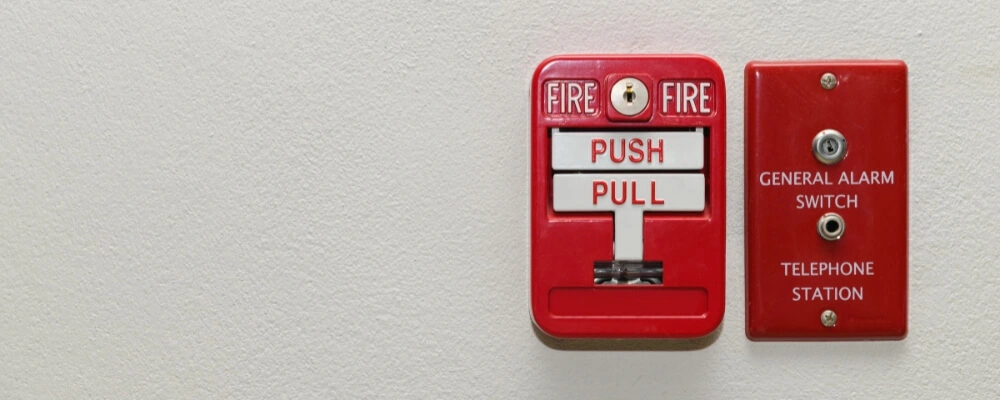
Types Of Fire Alarm System
Fire alarm systems come in various designs and complexities to meet the needs of different buildings, occupancies, and fire protection goals. The primary purpose of all these systems is to detect the presence of a fire and provide an alert, but the methods and technologies they use can differ. Here are the main types of fire alarm systems:
1. Conventional Fire Alarm Systems
- Functionality: In a conventional system, devices like detectors and manual call points are connected to the zones’ fire alarm control panel.
- Identification: When an alarm is triggered, the control panel can identify which zone the alarm comes from but not the specific device.
- Application: They’re typically used in smaller properties or areas where pinpointing the exact location of the alarm isn’t critical.
2. Addressable (or Intelligent) Fire Alarm Systems
- Functionality: Each device in this system has a unique address, and they’re all connected to the main control panel using a loop.
- Identification: The control panel can identify which specific device has been activated.
- Application: They’re ideal for larger buildings or complex environments because they provide precise information about where a potential fire is located.
3. Analog Addressable Fire Alarm Systems
- Functionality: These are advanced versions of addressable systems. They can measure the environment in detail and provide data to the control panel.
- Identification: Beyond identifying the activated device, they can relay more granular data, such as the exact smoke density.
- Application: Used in environments where detailed information is crucial, like large commercial buildings or sites with multiple buildings.

4. Wireless (or Radio) Fire Alarm Systems
- Functionality: Instead of using physical cables, these systems use radio signals to communicate between the control panel and the individual alarm system components.
- Identification: Depending on the system, it can provide zone-specific information like conventional or device-specific information like addressable systems.
- Application: Useful in places where cabling is challenging to install or in heritage buildings where drilling and cabling can be damaging.
5. Hybrid Fire Alarm Systems
- Functionality: As the name suggests, hybrid systems combine wired and wireless alarm system features.
- Identification: They can offer a mix of zone-specific or device-specific alerts based on their configuration.
- Application: Suitable for buildings that might benefit from a combination of wired and wireless systems, such as when expanding or upgrading an existing wired system.
6. Voice Evacuation Systems
- Functionality: Along with the standard alarm, these systems use voice instructions to guide occupants on evacuating safely.
- Identification: It can be integrated with addressable systems for specific location information.
- Application: Often used in large public buildings, theaters, or places with large crowds to ensure orderly and efficient evacuations.
Each type of fire alarm system has its advantages and is chosen based on factors like the size and type of the building, the potential fire risks present, the complexity required in the system, and the budget available for installation and maintenance.
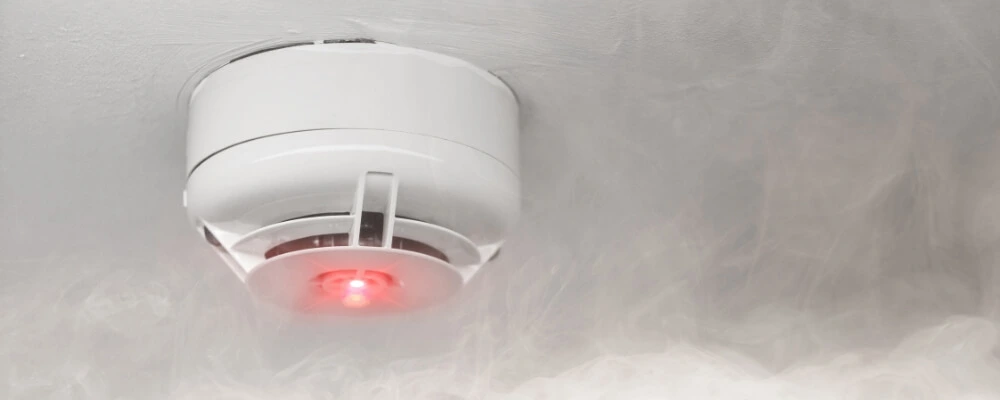
Different Components Of Fire Alarm System
Fire alarm systems consist of various interconnected components, each designed to perform a specific function within the overall system. These components work collectively to detect fires at their early stages, alert occupants, and sometimes even control the fire. Here’s a detailed look at the major components of a fire alarm system:
1. Control Panel
The control panel is essentially the central hub or the “brain” of the fire alarm system. It processes information received from various devices, making crucial decisions based on the inputs. Once it receives a signal from an initiating device, it assesses the information and activates the appropriate notification appliances to warn building occupants.
Beyond this primary function, the control panel interfaces with other security or building management systems, ensuring seamless integration. There are primarily three types of control panels. Conventional panels identify a zone or area of activation but do not specify the exact device triggered.
On the other hand, addressable panels communicate with each device individually, pinpointing the exact activation location. Hybrid panels combine features from conventional and addressable systems, offering flexibility in installation and operation.
2. Initiating Devices
Initiating devices act as the eyes and ears of the fire alarm system. They constantly monitor the environment for signs of fire or smoke. These devices send signals to the control panel when a potential fire situation is detected. Manual Pull Stations are straightforward – they are activated by people when they see indications of a fire.
Smoke Detectors come in different technologies. Ionization types are more responsive to flaming fires, while photoelectric types are more sensitive to fires that begin with a long period of smoldering. Heat Detectors get activated when a certain temperature threshold is exceeded or if there’s a rapid temperature rise. Flame Detectors work by identifying specific wavelengths of light emitted by flames.
Duct Detectors are specialized devices placed within HVAC systems. Their role is crucial in preventing the spread of smoke throughout the building. Finally, Waterflow Switches in sprinkler systems sense water movement, indicating that the sprinklers have been activated.
3. Notification Appliances
The primary role of notification appliances is to ensure that occupants are promptly and effectively alerted to potential fire hazards. Audible Devices, like bells or sirens, create loud sounds. On the visual front, devices like strobe lights or flashing LED indicators provide clear visual alerts.
For spaces like hospitals or nursing homes where loud noises might be disruptive, softer chimes can be used. Voice Evacuation Systems are increasingly popular as they provide clear voice instructions on how occupants should evacuate, making the process more organized and less prone to panic-induced chaos.
4. Power Supplies
Power is fundamental to the operation of the fire alarm system. The Primary Power Supply usually draws from the building’s main electrical supply. However, reliability is crucial for fire systems. Hence, there’s a Secondary Power Supply – typically batteries that can support the system for at least 24 hours if the primary supply fails.
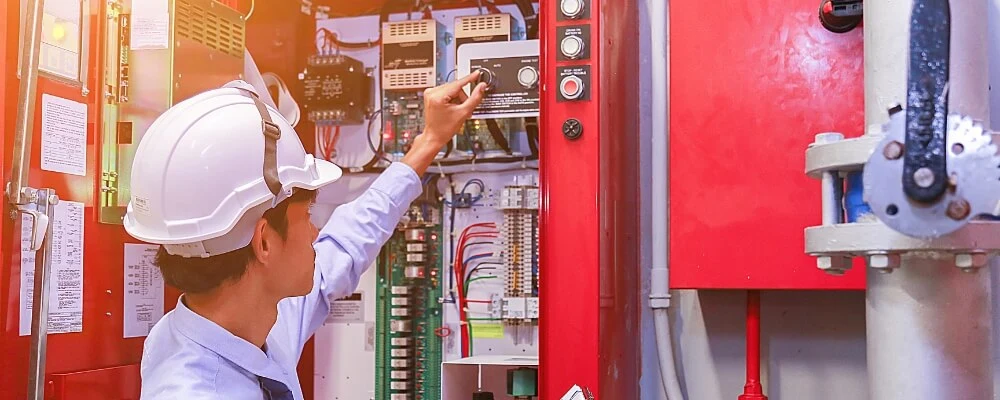
5. Communication Interfaces
Modern fire alarm systems are often integrated with other systems or monitored externally. Digital Alarm Communicator Transmitters (DACT) connect the fire alarm system to an external monitoring service, often using phone lines. This ensures that fires can be detected even if a building is unoccupied and emergency services are alerted.
Relays are vital components that allow the fire alarm system to interact with and control other systems within a building. For instance, it’s essential to shut down HVAC systems or recall elevators to the ground floor in a fire, and relays enable such functionalities.
6. Annunciators
These visual displays provide a snapshot of the fire alarm system’s status. Typically located at building entrances or security desks for easy accessibility, annunciators range from simple LED panels showing which zone was triggered to sophisticated LCD panels that display detailed information, such as the specific device activated.
7. Auxiliary Devices
These devices enhance the core functionalities of the fire alarm system. For example, Door Holders are electromagnetic devices that hold fire doors open to facilitate movement. In case of an alarm, they release the doors to prevent fire or smoke from spreading. Smoke Control Systems have a unique job – they regulate airflow in a building to manage and limit smoke movement, protecting escape routes and reducing damage.
8. Wiring
A wiring network crisscrosses the building, connecting every fire alarm system component to the control panel. The Initiating Device Circuits (IDC) are fundamental as they connect all initiating devices to the control panel, transmitting signals when an event is detected.
In advanced addressable systems, Signaling Line Circuits (SLC) play a pivotal role. Multiple devices are connected on a single loop of wire, but each has a unique address, enabling the system to identify the exact device that’s been activated.
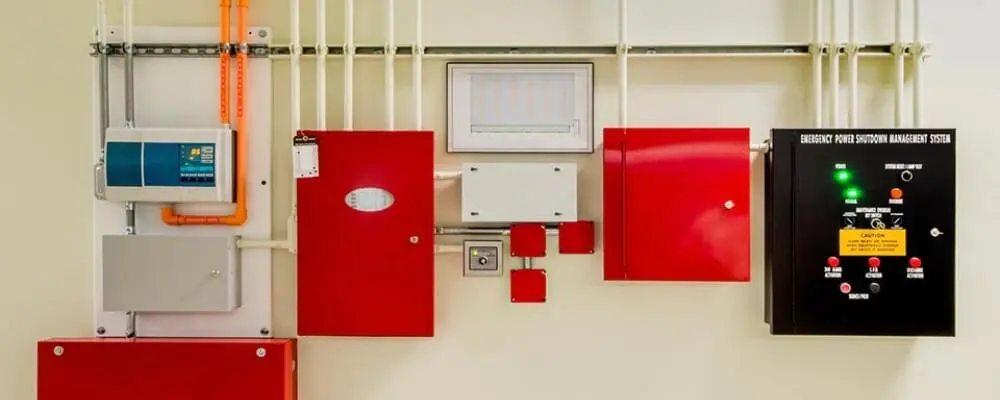
Fire Alarm System Installation Process
Installing a fire alarm system is a crucial task that ensures the safety and protection of a building’s occupants. It involves careful planning, design, and execution. Here’s a step-by-step explanation of the process:
1. System Planning and Design
- Needs Assessment: Before any installation begins, determine the requirements of the building. Factors like the building’s size, purpose (residential, commercial, industrial), and specific high-risk areas are considered.
- Choose System Type: Depending on the building’s requirements and budget, decide between a conventional or addressable fire alarm system.
- Layout Design: Plan where devices like detectors, pull stations, and notification appliances will be placed. Ensure adequate coverage without any “blind spots.”
2. Power Off
- Always ensure the electricity supply is turned off when working on electrical systems. This step is critical to avoid any accidents or electrical shorts.
3. Installation of Control Panel
- Choose a central, easily accessible location near the main entrance or security room.
- Secure the control panel to the wall and begin wiring according to the manufacturer’s instructions.
4. Installing Detectors
- Location: Smoke detectors are typically installed on ceilings as smoke rises. Heat detectors are often placed in kitchens or boiler rooms where rapid temperature changes might occur.
- Wiring: Run the appropriate cables from the control panel to each detector. Ensure that the wiring is neat and secure.
5. Install Manual Call Points/Pull Stations
- Place these near exits and entrances, ensuring they’re easily accessible to building occupants.
- Connect each pull station to the control panel using the designated wiring.
6. Installing Notification Devices
- Location: Install alarms (sirens, bells) and visual indicators (strobe lights) in visible and audible areas.
- Wiring: Like detectors, run cables from the control panel to each notification device.
7. Setting Up Communication Interfaces
- If the system is monitored, install communication devices like digital alarm communicators.
- Ensure these devices can send signals to the monitoring center when the fire alarm is activated.
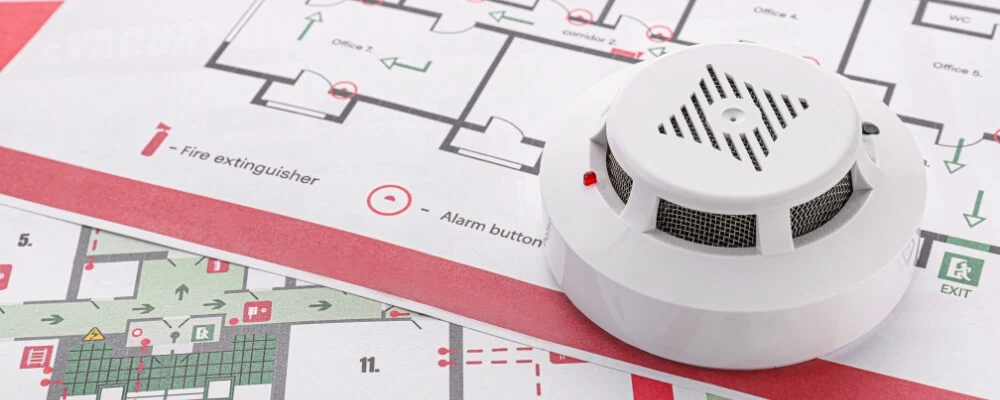
8. Power Supplies and Backup
- Connect the fire alarm system to its primary power source.
- Install backup batteries, ensuring they provide power during outages.
9. System Integration
- If the building has other systems like HVAC, integrate the fire alarm system to ensure, for example, the HVAC system shuts down during a fire to prevent the spread of smoke.
10. System Testing
- Once everything is installed, power on the system.
- Test each device, from detectors to pull stations, ensuring they communicate with the control panel and activate the notification devices.
- Regular testing should be part of maintenance to ensure the system’s functionality over time.
11. Training and Documentation
- Train building staff or occupants on manual call points and what to do during an alarm.
- Provide a complete system manual, including device locations and maintenance procedures.
12. Regular Maintenance
Schedule periodic checks and maintenance to ensure the system’s longevity and effectiveness.
Replace faulty devices and batteries as needed.
In conclusion, installing a fire alarm system is a structured process that ensures the safety of a building and its occupants. Proper planning, professional installation, and regular maintenance are critical to the system’s effectiveness.
Conclusion
The significance of a fire alarm system transcends mere code compliance or ticking off a safety checklist. It embodies our commitment to protect lives, assets, and memories. As we’ve journeyed through the various types, integral components, and meticulous installation process, it becomes evident that a fire alarm system is a culmination of advanced technology and human ingenuity working hand in hand to safeguard our spaces.
Whether upgrading an existing system or installing one afresh, the knowledge you’ve gleaned from this guide is invaluable. Remember, a proactive approach to safety averts potential tragedies and ensures peace of mind. Prioritize a robust fire alarm system — because every second counts regarding safety.

